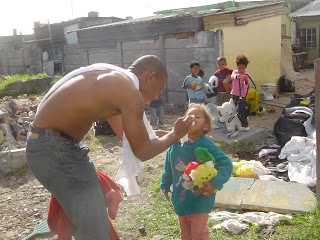Today was our much anticipated excursion to Soweto –the hotbed of anti-Apartheid force. We walked the only street in the world that once housed two Nobel Peace Prize Laureates – Nelson Mandela and Archbishop Desmond Tutu. Another point of Soweto pride is their recognition for sparking the youth uprising and its pivotal role in the fight for equality.
We learned much about the youth uprising at the Hector Peterson Memorial—dedicated to the first young boy to be killed in the freedom struggle at Soweto, June 16th. The museum was very powerful and impacted us greatly as it exposed us to photos, video-clips and first-hand accounts of passive resistance that turned into tragedy. We were inspired as both fellow students and democratic citizens. We were encouraged to see the power of students. The Apartheid regime tried to brainwash the Black youth under Bantu education. In 1963, Prime Minister, H.F. Verwoerd, the “architect of Apartheid” exemplifies the ruling party’s manipulative antics: “When I have control over native education, I will reform it so that natives will be taught from childhood that equality with Europeans is not for them.”
Fortunately, racial issues contextualized in the education system in America were less ideologically corrupt, but we still see many similarities between the struggles of our two countries. Similar to pre-Brown v. Board of Education America, the South African Apartheid regime demanded separation. Only, Apartheid did not claim “separate but equal…” in fact, they made sure separate was not equal.
We also had the opportunity to tour Nelson Mandela’s home where he resided with his second wife and children before his imprisonment. We were able to see how deeply his family was affected by the struggle, Winnie, his ex-wife, was imprisoned numerous times, banished, and forced to fortify her home to protect her children from attacks and gun fire. Later she became the President of the Women’s League of the A.N.C.
Some of our group had the great fortune of running into the Ambassador of Argentina with which they shared marvelous conversation from education and perceptions of culture to exactly what the FIFA World Cup is bringing to individuals and entire societies.
Next we enjoyed some local flavor at Wandie’s, a popular and authentic dining and music spot, but not before we almost purchased three painfully cute pups for the U.S. equivalent of $4 a piece. They were being sold by three adorable young entrepreneurs.
Hunger satisfied, we met up with a Professor Durseit and a student from University of Witwaterstrand in the Newtown section of Johannesburg. They showed how history impacts the culture of public spaces. Uniquely, Newtown enjoyed lively and inter-racial socialites who were allowed to enjoy performances at the Market Theatre, the only place during Apartheid where all races could perform on-stage together. After exploring the gentrified section of Newtown including the inner-city Gold-mine barracks which is now a historical site, we walked the back streets and saw first-hand how the government continues to stifle class interaction. On our left was an underground hip-hop venue and on our right were bridge pillars covered in graffiti art. The masterpieces were made by a famous artist, Rasti, for a youth celebration of empowerment on Freedom Day. In many of these areas, sadly, the pressures of commerce have cashed in and urban hot-spots have been replaced with governmentally controlled development.
The city’s vibrancy is apparent and hopefully the improvements brought on by hosting the FIFA World Cup will continue to uplift Johannesburg.




























































